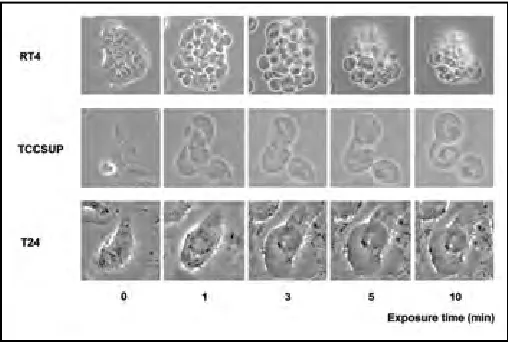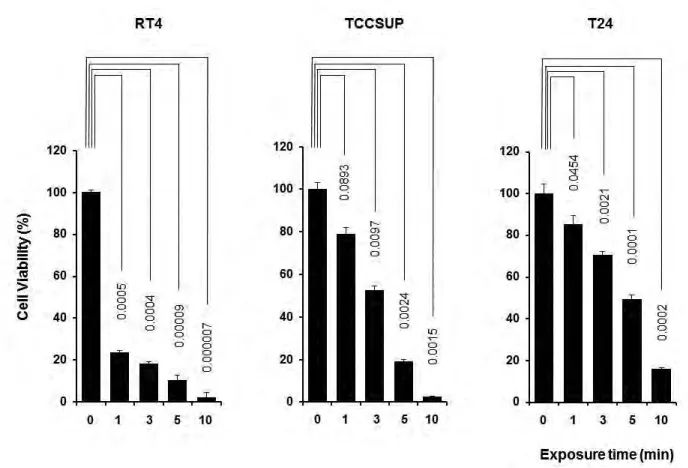Cite as: Can Urol Assoc J 2015;9(3-4):e109-13. http://dx.doi.org/10.5489/cuaj.2435 Published online March 11, 2015.
Abstract
Introduction
Radical cystectomy is the main stay of therapy for muscle-invasive bladder cancer. Despite well-performed surgeries, the cure rates with surgery alone are 52% to 72.9% for organ-confined disease.1,2 In patients who develop a pelvic
recurrence after surgery, cure rates are extremely poor at 3%.3 While some pelvic recurrences are explained by posi-tive margins, many are not. It has been hypothesized by ing potential, and local recurrence.4-6 There are conflicting data regarding the utility of this approach; others have even considered intraperitoneal chemotherapy to lyse potential tumour cells.7,8
While studies have attempted to explain the exact molec-ular mechanism in support of intraperitoneal lavage with sterile water, its benefit is controversial. In one study ana-lyzing cultures of bladder cancer cells, sterile water led to significant cytolysis.9 The effect of sterile water was com-parable to mitomycin C in bladder cancer cells.9 In addi-tion, it was reported that the bladder irrigation with sterile water after transurethral resection reduced recurrence rates of non-muscle-invasive bladder cancer.10,11 While the effect of intraperitoneal lavage with sterile water has been stud-ied in colorectal12 and ovarian cancer,13 data are lacking in bladder cancer literature in regards to optimal duration of sterile water exposure. We investigated the effect of water on bladder cancer cells by analyzing changes in cellular morphology, viability, membrane integrity, and DNA frag-mentation at varying time points of water exposure.
Rikiya Taoka, MD; Stephen B. Williams, MD; Philip L. Ho, MD; Ashish M. Kamat, MD
Department of Urology, The University of Texas MD Anderson Cancer Center, Houston, TX
In-vitro cytocidal effect of water on bladder cancer cells: The
Methods
Cell culture and preparation
Human bladder cancer cell lines RT4 (low grade), T24 (high CO2 in a humidified atmosphere in MEM supplemented with 10% FBS, penicillin, streptomycin, vitamins, L-glutamine, Tokyo, Japan), and serial changes in bladder cancer cells were recorded at 0, 1, 3, 5, and 10 minutes using a 20× magnification.
A total of 5 × 103 cells/well were plated in 96-well plates. After 24 hours of incubation, these cells were exposed to suspended in medium and 2 × 105 cells were placed in each eppendorf tube. The cell suspension was centrifuged and the
Results
Discussion
Radical cystectomy with extended pelvic lymph node dis-section is the gold standard for patients with muscle-invasive bladder cancer. With advances in surgical technique and an improved understanding of the disease process, oncologic
outcomes have improved. However, many patients still recur despite these improvements.1,14
It is commonly believed that pelvic recurrence is infre- quent and is due to nodal metastasis and positive surgi-cal margins, however this is not entirely accurate. The Vanderbilt group reviewed their experience and found that
Fig. 2. Cell viability of bladder cancer cells after exposure to sterile water. The viability of RT4 cells started to decrease within short exposure to sterile water, while T24 cells showed resistance to sterile water treatment.
initial recurrence was most common in the pelvis, and was statistically related to lymphovascular invasion but not stage, positive margins or positive nodes.15 Reports such as these have prompted experts to suggest that a major cause of pel-vic recurrences might be seeding which occurs at the time of radical cystectomy, when viable tumour cells escape the surgical specimen.
A common practice among oncologic surgeons is to irri-gate the surgical field after surgical extirpation to potentially dilute and lyse viable tumour cells that might be free float-ing. While this practice is not unique to our institution or urology, there is little evidence to suggest the utility of this practice or appropriate duration of this treatment to have an effect on bladder cancer cell death.7 Prior research studies in colorectal and ovarian cancer show conflicting results in regards to the cytolytic efficacy of intraperitoneal lavage with sterile water.12,13 Furthermore, prior bladder cancer research has demonstrated conflicting evidence regarding the role of intraperitoneal lavage with sterile water.7-9
Our study was specifically intended to study the time course of events in bladder cancer cells after exposure to water. First, we confirmed the cytocidal effect of hypotonic shock induced by sterile water on bladder cancer cells. In particular, RT4 cells, derived from a low-grade tumour, clearly showed cell swelling followed by cell rupture after exposure to sterile water. T24 cells demonstrated limited hypotonic swelling with limited cell ruptures. Potentially, the strength of cytoskeleton, cell membrane or the expres-sion of chloride channels may differ among bladder cancer
cell lines of different grades as seen in other malignancies.16 While the concept of osmotic cell lysis is not novel, we were interestingly able to discern varying susceptibilities of dif-ferent bladder cancer cell lines to water induced-hypotonic shock effect.
Second, we calculated the duration of exposure to sterile water required to lyse bladder cancer cells of varying cell lines. This is the first study, to our knowledge, which was able to quantify the exposure time required to achieve cell lysis and decrease cell viability. The lytic effect of sterile water on tumour cells has been well-studied in a variety of cancer settings,7-9,13 however, the dwell time required to achieve cancer cell lysis has not been reported. We found the required duration of exposure to sterile water to severely limit the number of cancer cells in each bladder cell line by a re-incubation experiment.
In the present study, RT4 bladder cancer cells appeared to be the most sensitive to sterile water among the cell lines. Most of re-incubated RT4 cells could not survive after 10 minutes exposure to sterile water. These findings indicate the cytolytic efficacy of intraperitoneal lavage with sterile water for 10 minutes to some extent. On the other hand, T24 cells needed more than 30 minutes of exposure to ster-ile water to have a cytocidal effect. In the human setting, intraperitoneal lavage for 30 minutes or more is difficult at radical cystectomy. Sterile water lysis does not compensate for a low quality oncologic procedure.
Our findings must be interpreted in the context of the study design: our data were generated from cultured bladder
cancer cell lines of different grades in an in vitrosetting. In the clinical setting, inherit characteristics of patients’ cancer cells and immunology likely play a significant role not only in the survival of cancer cells. Even with these caveats, ster-ile water is readily available and relatively inexpensive. In addition, the simplicity of performing intraperitoneal lavage with sterile water does not add unnecessary complications to surgery other than the additional time required. While we also use (and encourage others to use, methods such as ligation of the distal ureteral stump, ligation of the urethra during surgery), the use of lavage is a simple measure that can aid in the lysis of cells that might escape the surgical specimen. Although there may be incremental benefits of increased cell lysis with additional exposure time of cancer cells to water, this needs to be individually weighed by the risk of prolonging the time of surgery for the patient.
Conclusion
Bladder cancer cell lines differ in their sensitivity to hypo-tonic shock of sterile water, with low-grade cells undergoing the fastest and most significant decrease in viability. The exposure to water is time dependent with increased tumour cell lysis observed with prolonged exposure.
Competing interests: Rikiya Taoka, Stephen B. Williams, Philip L. Ho, and Ashish M. Kamat all declare no competing financial or personal interests.
This paper has been peer-reviewed.
References
1. Stein JP, Lieskovsky G, Cote R, et al. Radical cystectomy in the treatment of invasive bladder cancer: Long-term results in 1,054 patients. J Clin Oncol 2001;19:666-75.
2. Gschwend JE, Dahm P, Fair WR. Disease specific survival as endpoint of outcome for bladder cancer patients following radical cystectomy. Eur Urol 2002;41:440-8. http://dx.doi.org/10.1016/S0302-2838(02)00060-X
3. Mitra AP, Quinn DI, Dorff TB, et al. Factors influencing post-recurrence survival in bladder cancer following radical cystectomy. BJU Int 2012;109:846-54. http://dx.doi.org/10.1111/j.1464-410X.2011.10455.x
4. Huguet EL, Keeling NJ. Distilled water peritoneal lavage after colorectal cancer surgery. Dis Colon Rectum 2004;47:2114-9. http://dx.doi.org/10.1007/s10350-004-0788-4
5. Brundell SM, Tucker K, Chatterton B, et al. The effect of lavage on intraabdominal cell burden. Surg Endosc 2002;16:1064-7. http://dx.doi.org/10.1007/s00464-001-9111-9
6. Lin CH, Hsieh HF, Yu JC, et al. Peritoneal lavage with distilled water during liver resection in patients with spontaneously ruptured hepatocellular carcinomas. J Surg Oncol 2006;94:255-6. http://dx.doi. org/10.1002/jso.20596
7. Mercill DB, Jones NR, Harbell JW. Human tumor cell destruction by distilled water. An in vitro evaluation. Cancer 1985;55:2779-82. http://dx.doi.org/10.1002/1097-0142(19850615)55:12<2779::AID-CNCR2820551210>3.0.CO;2-H
8. Abaza R, Keck RW, Selman SH. Intraperitoneal chemotherapy for the prevention of transitional cell carcino-ma implantation. J Urol 2006;175:2317-22. http://dx.doi.org/10.1016/S0022-5347(06)00257-6 9. Fechner G, Pocha K, Schmidt D, et al. Reducing recurrence and costs in superficial bladder cancer: Preclinical
evaluation of osmotic cytolysis by distilled water vs. mitomycin. Int J Clin Pract 2006;60:1178-80. http:// dx.doi.org/10.1111/j.1742-1241.2006.00847.x
10. Moskovitz B, Levin DR. Intravesical irrigation with distilled water during and immediately after transurethral resection and later for superficial bladder cancer. Eur Urol 1987;13:7-9.
11. Nikolaos G, Konstantinos H, Vasileios K, et al. Efficacy of postoperative bladder irrigation with water for injection in reducing recurrence rates of non-muscle invasive bladder cancer. Asian Pac J Cancer Prev 2014;15:2263-6. http://dx.doi.org/10.7314/APJCP.2014.15.5.2263
12. Ito F, Camoriano M, Seshadri M, et al. Water: A simple solution for tumor spillage. Ann Surg Oncol 2011;18:2357-63. http://dx.doi.org/10.1245/s10434-011-1588-4
13. Morris PC, Scholten V. Osmotic lysis of tumor spill in ovarian cancer: A murine model. Am J Obstet Gynecol 1996;175:1489-92. http://dx.doi.org/10.1016/S0002-9378(96)70095-9
14. Hautmann RE, Gschwend JE, de Petriconi RC, et al. Cystectomy for transitional cell carcinoma of the bladder: Results of a surgery only series in the neobladder era. J Urol 2006;176:486-92. http://dx.doi. org/10.1016/j.juro.2006.03.038
15. Hassan JM, Cookson MS, Smith JA Jr, et al. Patterns of initial transitional cell recurrence in patients after cystectomy. J Urol 2006;175:2054-7. http://dx.doi.org/10.1016/S0022-5347(06)00323-5 16. Kosuga T, Shiozaki A, Ichikawa D, et al. Pleural lavage with distilled water during surgery for esophageal
squamous cell carcinoma. Oncol Rep 2011;26:577-86.


